Why It’s Time to Stop Taxing Gold & Silver
By Jesse Colombo
You’d have to be hiding under a rock to be unaware that inflation is one of the most pressing issues of our time. After a shocking 23% increase in the cost of living since 2019, all but the wealthiest of Americans are getting squeezed and seeing their living standards plummet at an alarming rate. Grinding inflation is causing once-affluent people to become merely middle class, former middle-class people to become working class, while working class people are being forced into the ranks of the working poor and even the destitute. According to the most recent Gallup Poll, inflation was America’s number one worry with 55% of people polled saying that they worried about inflation “a great deal,” while the latest Fed survey showed that two-thirds of Americans believe that inflation has made their financial situation worse.
The sad truth is that inflation is not an inevitable fact of life or an inherent flaw of capitalism; it is a direct byproduct of unbacked paper money and central banking. The United States experienced virtually no inflation for over a century until the Federal Reserve was founded in 1913 and the U.S. dollar was progressively downgraded from a gold-backed currency to a paper currency that could be — and has been — printed to oblivion.
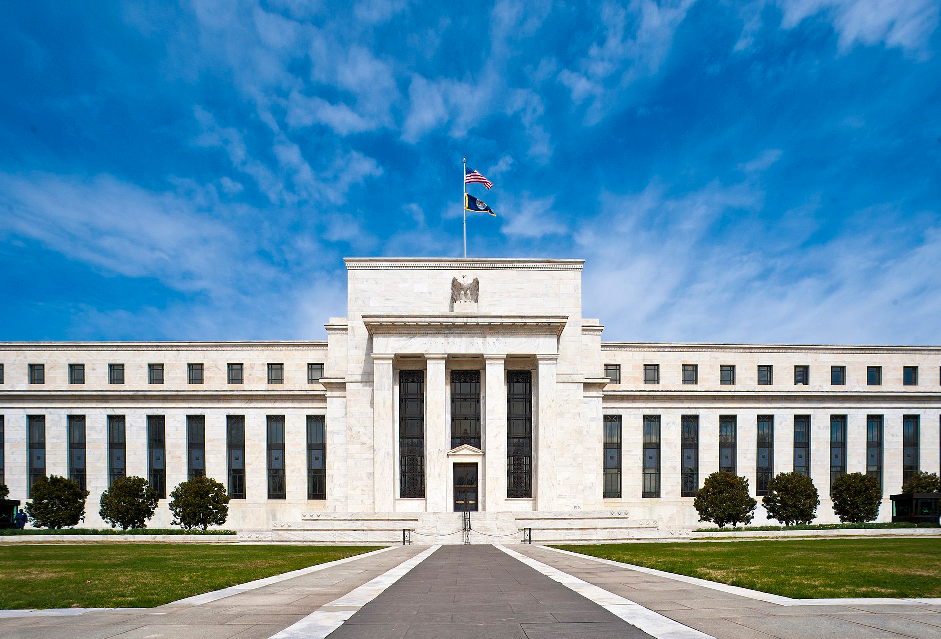
Though the U.S. is no longer on the gold standard, savers and investors have been able to effectively protect their wealth from the ravages of inflation by creating their own personal “gold standard,” so to speak, by investing in gold and silver bullion. Unfortunately, the U.S. government taxes capital gains on gold and silver bullion at an unfairly high rate, which is particularly infuriating because those so-called “gains” are not actually gains at all as they are simply compensation for the plunging purchasing power of the dollar, which is the U.S. government’s fault in the first place! Thankfully, as I will discuss later in this piece, there is a glimmer of hope in the form of a new bill that intends to eliminate U.S. federal capital gains taxes on physical gold and silver.
What is Inflation & What Causes It?
In order to truly understand the virtues of gold and silver, it’s important to understand inflation, what causes it, and how destructive it is to society. Simply stated, inflation is an increase in the money supply that manifests in the form of pricier goods and services as well as a loss of purchasing power of the currency that is being inflated. The money supply is the number of units of currency in existence; the more units in existence, the less each unit is worth.
Contrary to popular belief, the rising money supply itself is inflation; the rising cost of goods and services is just an inevitable consequence of that inflation. General inflation is always monetary in origin and is not caused by supply shocks such as an energy crisis or a drought that pushes up food prices. As the Nobel Prize-winning economist Milton Friedman famously stated, “Inflation is always and everywhere a monetary phenomenon.”
The long-term chart of the U.S. adjusted monetary base, which is one of several widely followed money supply measures, shows how the country’s money supply surged by an astounding 55,440% from 1920 to 2020. (Note that the Federal Reserve stopped publishing this data series in late-2019, which is serious reason for suspicion. Are they trying to hide how much they’ve debased the U.S. dollar? You decide.)
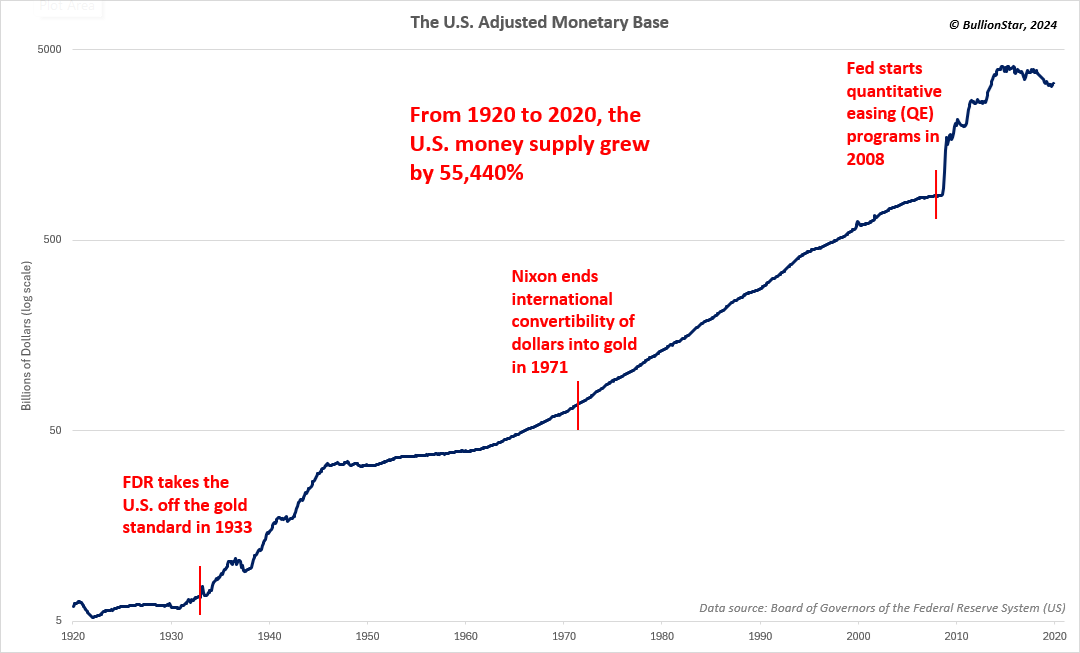
Though the U.S. money supply has grown as a function of time, there have been a series of pivotal events that have accelerated and further enabled that process:
- The U.S. Federal Reserve was founded in 1913 with the primary responsibility of issuing and managing the U.S. dollar. Unfortunately, it has proven to be a terrible steward of our nation’s currency because it has been all too willing to create new dollars to enable government spending. For example, the dollar lost half of its purchasing power within just six years of the Fed’s founding due to its funding of America’s role in World War I. Massive wartime inflation ensued, devastating the dollar’s purchasing power.
- President Franklin Delano Roosevelt took the U.S. off the Gold Standard in 1933. The United States was on the Gold Standard from 1834 until 1933, which meant that the dollar was backed by and redeemable in gold. For nearly a century, holders of dollars could trade $20.67 to receive an ounce of gold. The Gold Standard helped to limit the expansion of the money supply. To create inflation and counteract deflation during the Great Depression, FDR banned private American citizens from owning gold and forced them to turn in their gold to the Federal Reserve for $20.67 per ounce in 1933. Foreign governments could still redeem their dollars for gold, however. The dollar-gold exchange rate was then changed to $35 per ounce, which meant that the dollar was devalued by 59% against gold. Sure enough, the money supply and cost of living were soon increasing at a rapid rate once again.
- Until 1965, U.S. dimes, quarters, and half-dollars were made from an alloy that consisted of 90% silver. In response to the rising price of silver (which itself was a byproduct of inflation), Congress enacted the Coinage Act of 1965, which eliminated silver from dimes and quarters, and reduced the silver content of the half-dollar from 90% to 40%. In 1970, silver was eliminated from the half-dollar. The new coins were made from nickel and copper, which are much cheaper, non-precious metals. Because the melt value of the older silver coins exceeded their face values, the coins were quickly removed from circulation by people who were aware of their greater value — a classic example of Gresham’s Law (i.e. “bad money drives out good money"). The older silver coins are still very popular with precious metals investors today. The Coinage Act of 1965 is often overlooked but represents a significant debasement and downgrade of the U.S. dollar.
- From 1933 to 1971, foreign governments could still redeem their dollars for gold, which meant that the dollar was still backed by gold in some sense. On August 15th, 1971, President Richard Nixon ended all convertibility of dollars into gold, which turned the U.S. dollar into a pure fiat or paper currency that could be printed with no limitations whatsoever. Almost immediately, the money supply started growing at a breakneck pace, which led to the infamous inflation of the 1970s. The U.S. experienced an 8.21% average annual rate of inflation from 1971 to 1980, producing a cumulative price increase of 46%.
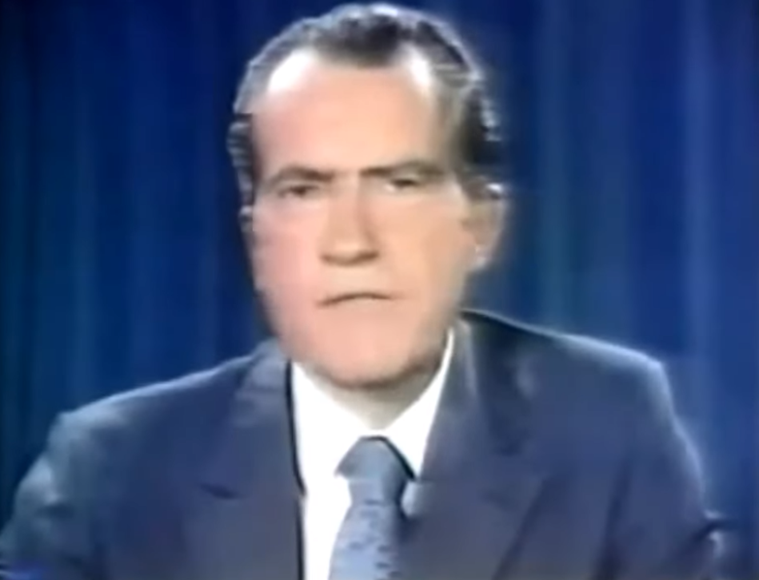
- To combat the 2008 Financial Crisis and Great Recession, the Federal Reserve used an unconventional and aggressive monetary stimulus tool known as quantitative easing or QE. In simple terms, QE is digital money printing in which the Fed buys assets such as U.S. Treasury bonds and mortgage bonds in order to fund government spending and pump liquidity into the economy and financial markets. From 2008 to 2014, the Fed printed approximately $3.5 trillion via its QE programs, which caused the money supply and cost of living to soar.
- After its trial run in 2008, quantitative easing became a permanent tool in the Fed’s toolbox. After all, what government wouldn’t want the ability to fund its increasingly reckless spending with money created out of thin air? When the COVID-19 pandemic came along in 2020, the Fed quickly created approximately $5 trillion worth of new currency via QE to keep the economy afloat during the government-imposed lockdowns. That $5 trillion funded a dizzying number of stimulus programs including the purchase of debt securities and other assets, PPP loans, stimulus checks, and generous unemployment benefits. Unfortunately, that sharp expansion of the money supply caused a cumulative price increase of 23% since 2019 and has made so many Americans’ lives miserable in the process.
The long-term U.S. Consumer Price Index chart going back to 1800 shows how each progressive assault on the dollar’s integrity caused the cost of living to skyrocket while causing the dollar’s purchasing power to plummet. Most people are unaware that U.S. consumer prices were largely stable for nearly a century until the Federal Reserve was founded in 1913, which let the inflation genie out of the bottle in a tremendous way. Since the Fed was founded, U.S. consumer prices have increased more than thirty-fold! It’s hard to imagine a time when there wasn’t steady and consistent inflation, but that was the reality in the 19th century when money — thanks to its backing by gold and silver — was far sounder than it is today despite our advanced technology and accumulated knowledge.
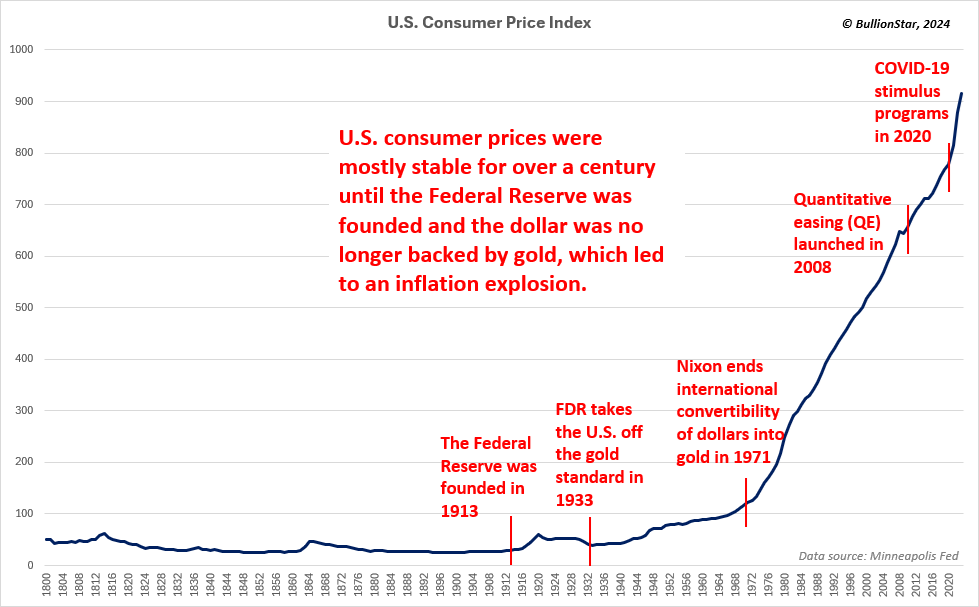
Since the Fed was founded in 1913, the U.S. dollar has lost nearly 97% of its purchasing power and there is no end in sight, unfortunately:
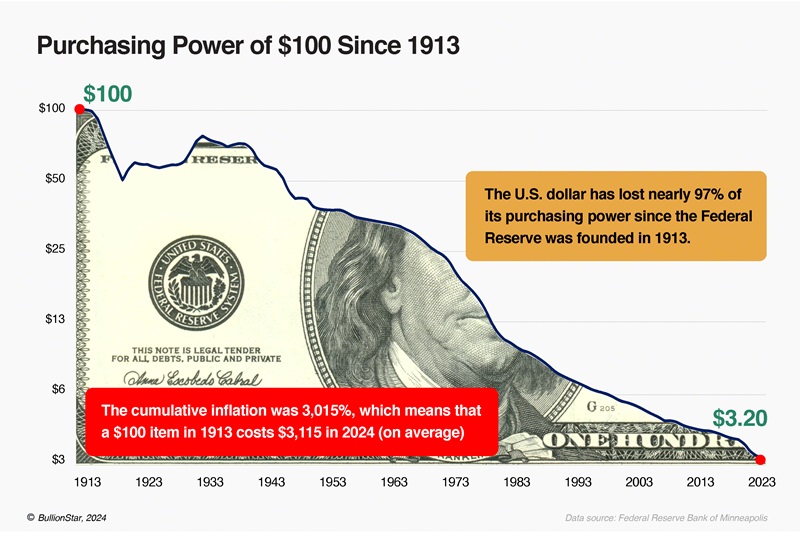
Another way of visualizing the dollar’s stunning loss of purchasing power is by comparing it to gold, which has been used as money for six thousand years and is the most stable store of value in existence. Over the past century, the U.S. dollar’s purchasing power has plunged by 99.17% relative to gold:
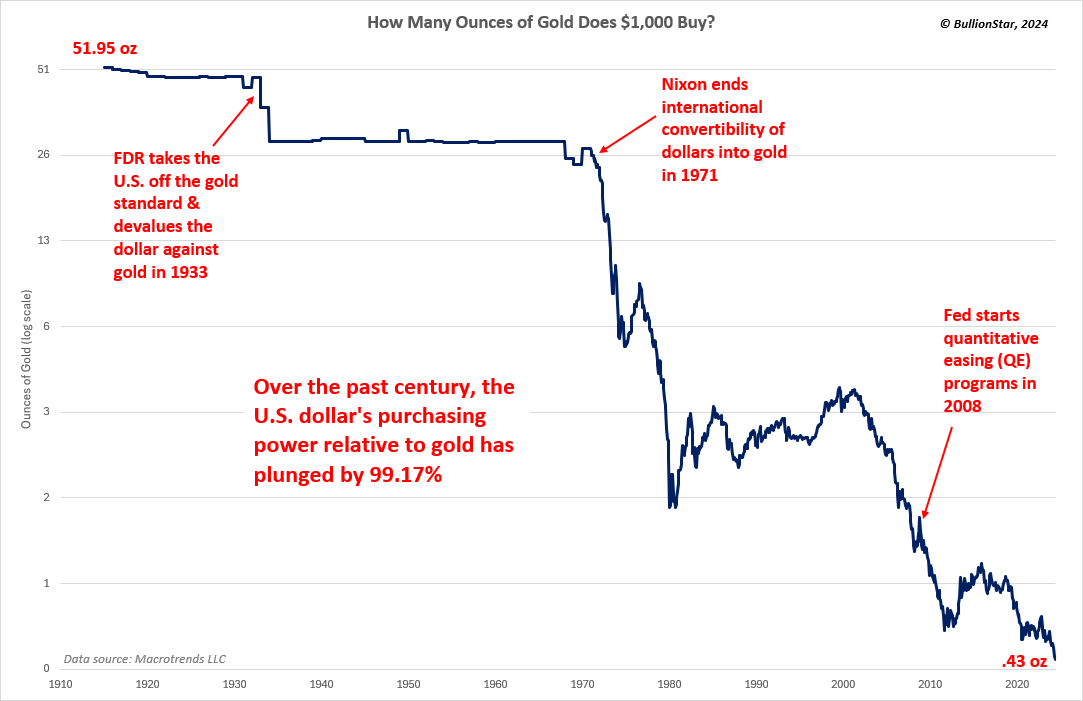
Here are some tangible and relatable examples of how the destruction of the dollar affects everyday Americans:
- An income of over $200,000 per year is needed for a family of four to live comfortably. In some states like California, New York, Massachusetts, and Connecticut, an income of approximately $300,000 is necessary for a family to live comfortably. Meanwhile, the average annual salary is just $59,428, 74% of Americans are living paycheck-to-paycheck, and 67% are unable to cover an unexpected $400 expense.
- The surge of inflation since the pandemic means that the average American household must spend an additional $11,434 annually just to maintain the same standard of living that they had in January of 2021.
- It now costs more than $1,000 a month to feed a family.
- Since President Biden took office in 2021, the cost of groceries is up 21%, gasoline is up 47%, shelter is up 20%, electricity is up nearly 30%.
- The median U.S. home price just hit an all-time high of $434,000, which is a roughly 30% increase since the pandemic started. As a result, first-time buyers need a household income of nearly $120,000 just to afford a median-priced home.
- Those who can’t afford to buy a home are typically forced to rent, but with the typical monthly rent now $1,957, even renting has become unaffordable for a record half of all renters.
- The average cost of health insurance for a family of four is approximately $23,968 per year.
- It now costs roughly $306,924 to raise a child through age 17.
- The average American family can expect to spend $1,984 per month on child care, which is more than a mortgage payment or rent almost everywhere in the United States.
- The average cost of a new vehicle is a near-record $48,510.
There are many other examples like the ones above, but the message is clear — even a modest lifestyle is becoming almost impossible in America, and it’s entirely the fault of the U.S. government, the Federal Reserve, and a currency that isn’t backed by anything. As the quote commonly attributed to Thomas Jefferson presciently states, “If the American people ever allow private banks to control the issue of their currency, first by inflation, then by deflation, the banks and corporations that will grow up around them will deprive the people of all property until their children wake up homeless on the continent their fathers conquered.”
Sure enough, the U.S. homeless population surged by 12% in 2023 to the highest level in at least fifteen years and is only going to grow worse as the dollar is debased as a function of time. We are in a very different world from the one in which a father could support a family comfortably on one income while going on annual family vacations and saving money for retirement and their children’s educations, as was common in the mid-to-late twentieth century; that’s the difference between life with sound money and life without sound money.

Here are some of the best quotes about inflation and its devastating effect on living standards:
- “The way to crush the bourgeoisie is to grind them between the millstones of taxation and inflation.” ― Vladimir Lenin, founder & first leader of the Soviet Union
- “Lenin is said to have declared that the best way to destroy the capitalist system was to debauch the currency. By a continuing process of inflation, governments can confiscate, secretly and unobserved, an important part of the wealth of their citizens. By this method they not only confiscate, but they confiscate arbitrarily; and, while the process impoverishes many, it actually enriches some…the process engages all the hidden forces of economic law on the side of destruction and does it in a manner which not one man in a million is able to diagnose.” ― John Maynard Keynes, economist
- “As I have repeatedly said, inflation is a form of taxation without representation. It is the kind of tax that can be imposed without being legislated by the authorities and without having to employ additional tax collectors.” ― Milton Friedman, Nobel Prize-winning economist
- “[Inflation] is a way to take people’s wealth from them without having to openly raise taxes. Inflation is the most universal tax of all.” ― Thomas Sowell, economist
- “In the absence of the gold standard, there is no way to protect savings from confiscation through inflation. There is no safe store of value.” ― Alan Greenspan, economist & former Fed chairman
How Gold & Silver Protect Wealth
As we have seen, the U.S. government and Federal Reserve’s constant assault on the paper dollar makes it a terrible store of value and it will continue to be diluted to oblivion in the years and decades to come. The dollar is merely useful as a medium of exchange at best — a hot potato to be traded for useful goods and services as quickly as it is received. Anyone who is holding a large portion of their wealth in U.S. dollars over long periods of time is giving the government a license to steal their hard-earned wealth.
Unlike paper currencies, gold and silver bullion have proven to be the best stores of value for millennia. Gold and silver are extremely effective at preserving wealth because they can’t be printed or created out of thin air the way that paper currencies are, which means that their prices rise over time as the paper money supply grows. Holders of gold and silver see the value of their assets rise while the currency is debased, which is what allows them to preserve their wealth.
It’s important to point out, however, that gold and silver are not actually rising in value in an absolute sense; the paper currencies that gold and silver are denominated in are losing value due to debasement, which is why gold and silver appear to rise in price. In that scenario, gold and silver are simply maintaining their value and purchasing power — the so-called “gains” are illusory. A good example of this is how a quality men’s suit has long been worth the equivalent of one ounce of gold. In the 1930s, both a suit and an ounce of gold cost approximately $35. Now, nearly a century later, both cost around $2,300.
The chart below shows how gold follows the U.S. M2 money supply higher over the long run:
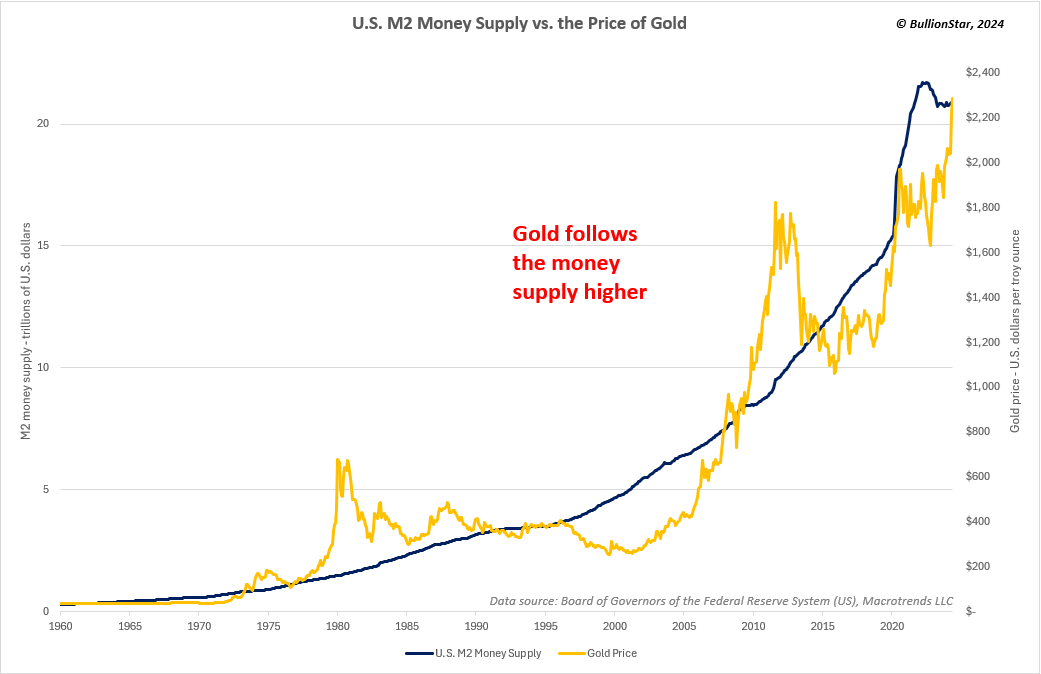
Silver also follows the money supply higher over time, though it is more volatile than gold and has longer periods of time when it lags or outpaces money supply growth:
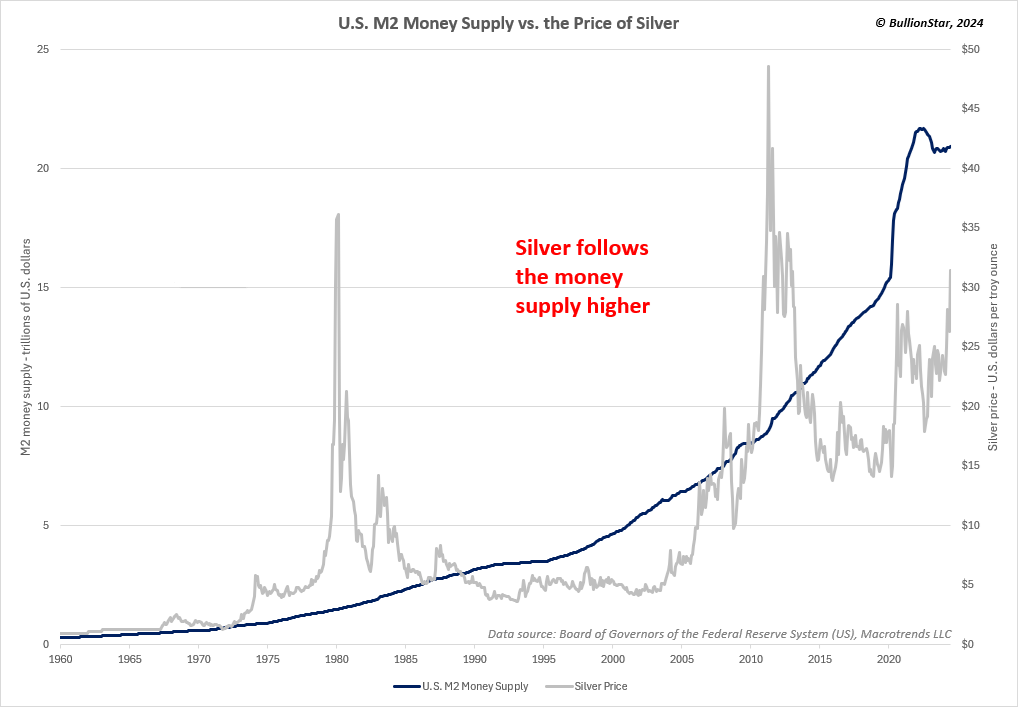
Why It’s Time to Stop Taxing Capital Gains on Gold & Silver Bullion
As we have seen, the United States government and Federal Reserve have been absolutely terrible stewards of the dollar and have crushed the middle class with their incessant debasement of our currency. It’s hard to imagine those institutions doing an even worse job than they already have — it’s practically criminal and any reasonable person can be forgiven for thinking that it’s being done knowingly and even intentionally. As the economist Milton Friedman so accurately stated, inflation is a form of taxation without representation, which was one of the main grievances that led our colonial American forefathers to revolt against Great Britain. The American people have virtually no say in how our currency is managed, yet we are forced to use that currency by law. We are completely trapped.
Though everyday Americans are essentially powerless concerning the management of our national currency, we have a few options for preserving our wealth at the individual level, such as the personal “gold standard” that I mentioned earlier in this piece (i.e., preserving wealth by investing in gold and silver bullion). As we’ve written about previously, there’s a major issue that makes that strategy far less effective than it should be and is holding it back from much wider adoption: U.S. federal capital gains taxes on gold and silver bullion.
The issue is not just that there are capital gains taxes on gold and silver bullion in the first place, but also that the capital gains tax rate on bullion is much higher than the capital gains tax rate on other investment assets. The U.S. Internal Revenue Service considers gold and silver bullion to be in the “collectibles” category — just like art, baseball cards, and Beanie Babies — and taxes capital gains on those items at a hefty 28% rate. In contrast, the long-term capital gains tax rate on stocks and bonds is just 15% for most people and even 0% for those with lower incomes. Essentially, the U.S. government is picking winners by showing favoritism toward stocks and bonds as opposed to gold and silver bullion.
It’s extremely unfair for the U.S. government to tax so-called capital gains on gold and silver bullion when those “gains” are not really gains at all but are the result of the debasement of paper money, which is the very fault of the U.S. government! That’s a perfect example of how we are “being ground between the millstones of taxation and inflation,” as Vladimir Lenin put it. People don’t invest in gold and silver bullion to get rich; they’re just looking to preserve their wealth. People who are looking to get rich typically gravitate toward hot, speculative tech stocks, cryptocurrencies, and flipping houses — not staid gold and silver bullion, which is commonly derided as a “Boomer investment” by today’s young, hotshot crypto speculators (though I don’t agree with them, of course).
Introducing The Monetary Metals Tax Neutrality Act
A couple of weeks ago, I was pleasantly surprised to learn that there was a new bill called The Monetary Metals Tax Neutrality Act (H.R. 8279) that aims remove all federal income taxation from gold and silver bullion. The bill was introduced by U.S. Representative Alex Mooney (R-WV) and backed by the Sound Money Defense League and other free-market activists. Representatives Scott Perry (R-PA) and Randy Weber (R-TX) also cosponsored the bill. “My view, which is backed up by language in the U.S. Constitution, is that gold and silver coins are money and are legal tender,” Rep. Mooney said. Mooney further stated, “If they’re indeed U.S. money, it seems there should be no taxes on them at all. So, why are we taxing these coins as collectibles?”
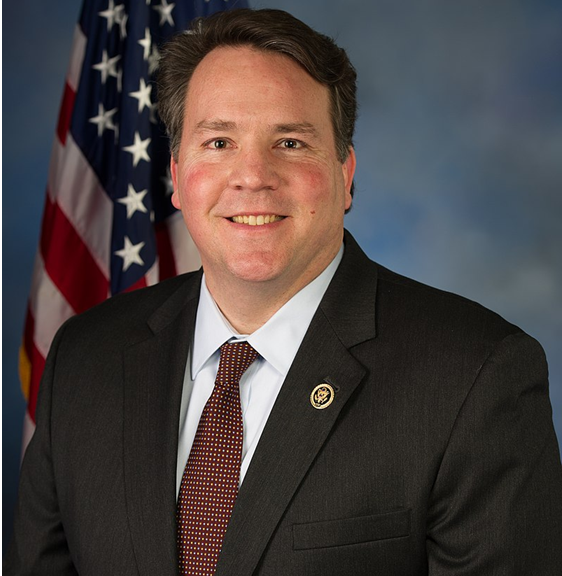
According to the Sound Money Defense League’s press release:
“Sound money activists have long pointed out it is inappropriate to apply any federal income tax, regardless of the rate, against the only kind of money named in the U.S. Constitution. And the IRS has never defended how its position squares up with current law.
Furthermore, the U.S. Mint continuously mints coins of gold, silver, platinum, and palladium and gives each of these coins a legal tender value denominated in U.S. dollars. This formal status as U.S. money further underscores the peculiarity of the IRS’s tax treatment.”
(It is also worth pointing out that many countries around the world don’t impose capital gains taxes on gold and silver bullion including Bahrain, Barbados, Belize, the Cayman Islands, the Isle of Man, Jamaica, New Zealand, Sri Lanka, Singapore, and others.)
The Sound Money Defense League’s press release also stated:
“The Monetary Metals Tax Neutrality Act aligns with a broader national trend. With most states having already eliminated sales tax on the purchase of precious metals, state legislatures are increasingly introducing and approving measures to eliminate state income taxation of gold and silver.
Alabama and Nebraska each passed their version of this policy this year. Arizona, Arkansas, and Utah approved similar measures in recent years. And Iowa, Georgia, Oklahoma, Missouri, and Kansas also considered income tax exemptions in 2024, with several approving the bill across multiple committees and chambers.”
You can read the text of H.R. 8279 here and track its status here.
Everyone who believes in sound money, justice, and fairness should support The Monetary Metals Tax Neutrality Act. To do so, please contact your local elected officials and let them know that you support this bill and feel free to forward them this article as it explains the flaws of paper money and central banking, as well as how gold and silver bullion have helped people preserve their wealth for thousands of years. Also, you can use Twitter/X to reach out to Rep. Alex Mooney, the Sound Money Defense League, and the Sound Money Defense League’s Policy Director Jp Cortez to ask them how you can help and get involved in supporting this important bill. BullionStar has always been a vocal proponent of sound money and free markets, and will continue to support this bill and the overall movement to the best of our ability.

Popular Blog Posts by BullionStar
 How Much Gold is in the FIFA World Cup Trophy?
How Much Gold is in the FIFA World Cup Trophy?
 Essentials of China's Gold Market
Essentials of China's Gold Market
 Singapore Rated the World’s Safest & Most Secure Nation
Singapore Rated the World’s Safest & Most Secure Nation
 Infographic: Gold Exchange-Traded Fund (ETF) Mechanics
Infographic: Gold Exchange-Traded Fund (ETF) Mechanics
 BullionStar Financials FY 2020 – Year in Review
BullionStar Financials FY 2020 – Year in Review
 The U.S. Dollar’s Decline: Why Precious Metals Matter More Than Ever
The U.S. Dollar’s Decline: Why Precious Metals Matter More Than Ever
 Secure Gold Storage in Singapore: Inside BullionStar’s Premier Vault Facility
Secure Gold Storage in Singapore: Inside BullionStar’s Premier Vault Facility
 Is Costco Gold a Good Deal? What You Need to Know Before You Buy
Is Costco Gold a Good Deal? What You Need to Know Before You Buy
 Bitcoin Slows, Gold Glows: What’s Driving the Shift in 2025?
Bitcoin Slows, Gold Glows: What’s Driving the Shift in 2025?
 Fort Knox Gold: A Historic Opportunity for Transparency in America’s Most Famous Vault
Fort Knox Gold: A Historic Opportunity for Transparency in America’s Most Famous Vault




 BullionStar
BullionStar 0 Comments
0 Comments












